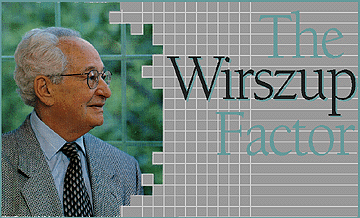
The University of Chicago Magazine
October-December 1996

Whether championing the cause of improved mathematics education or showering hospitality on students and colleagues, Izaak Wirszup has made his life's work making a difference.
By William Harms
Photography by Dan Dry
 n a characteristic act of kindness, Izaak Wirszup took a special interest in a young man who arrived at his Eckhart Hall office one chilly winter day in 1979. He had come to see the U of C professor's vast collection of mathematics and computer textbooks from the Soviet Union. Although neither William McHenry nor Wirszup knew it, the visit would help bring about a major improvement in the way U.S. schoolchildren learn math.
n a characteristic act of kindness, Izaak Wirszup took a special interest in a young man who arrived at his Eckhart Hall office one chilly winter day in 1979. He had come to see the U of C professor's vast collection of mathematics and computer textbooks from the Soviet Union. Although neither William McHenry nor Wirszup knew it, the visit would help bring about a major improvement in the way U.S. schoolchildren learn math.As a graduate student at the University of Virginia, McHenry was studying how computers were used in the Soviet Union and wanted to see firsthand the materials that Wirszup had been gathering for more than two decades.
With the help of grants from the National Science Foundation, Wirszup, PhD'55, had edited or coedited translations of more than a dozen volumes of Soviet research into the psychology of mathematics education since his 1956 appointment as director of the Survey of Recent East European Mathematical Literature. Over the years, Izaak Wirszup's academic project had taken on the fervor of a personal mission: to alert Americans to the weaknesses of mathematics learning in their country. His 1979 report to the NSF on the comparative strength of Soviet math and science education quickly reached President Jimmy Carter, and the result was a White Houseinitiated reevaluation of the adequacy of American schools.
Wirszup's missionary zeal, however, didn't blind him to details of the here-and-now, and his young visitor's apparel caught his eye. "He was wearing tennis shoes and a sweater,"
Continue reading "The Wirszup Factor"
Sidebar: "Large Numbers on Campus," about the U of C School Mathematics Project
William Harms is senior staff writer in the University's News and Information Office.
Go to:
- INVESTIGATIONS
- CHICAGO JOURNAL
- EVENTS
- LETTERS
- CHICAGOPHILE
- Feature story, "The Strange Laboratory of Dr. LaBarbera"
- Feature story, "Strength in Numbers"
- Special Report, "Building a Strong Cornerstone"
- Feature story, "The Wirszup Factor"
- CLASS NEWS
- DEATHS
- BOOKS BY ALUMNI
- IN THE CLUBS
Return to October-December 1996 Table of Contents